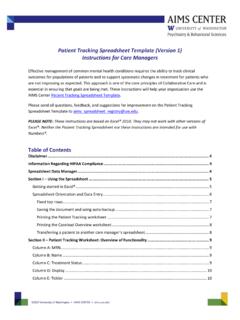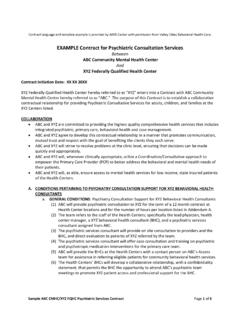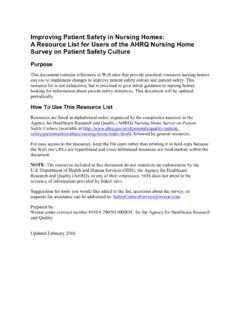Transcription of Developing Protocols for Suicide Prevention in Primary Care
1 Developing Protocols for Suicide Prevention in Primary care Primary care clinics have a responsibility to provide effective and efficient Suicide safe care that is accessible to all patients and staff. Developing a thoughtful and clear protocol and workflow for responding to suicidality in your Primary care setting will empower staff to know how to act as well as help to keep patients and staff safe. This information is intended to guide Primary care clinics to refine existing protocol(s) for responding to patients presenting with suicidality or violent behavior in a Primary care clinic.
2 Principles 1. All clinic staff are informed and supported. One-page workflows for responding to suicidal ideation and violent behaviors should be easily accessible to all staff (not just the behavioral health staff or the clinic manager). These workflows should clearly outline when and how to respond, who to engage, and list internal and external resources for such clinic events. A clinic should also provide guidance for when suicidal ideation is expressed over the phone by patients and non-patients, as well as suicidal ideation expressed by walk in patients.
3 Local crisis line and national Suicide hotline contact information should be made visible throughout patient areas in the clinic. And staff are informed on how to contact the crisis response teams if available in your setting. 2. Do not use safety contracts or no- Suicide contracts . There is no evidence that contracting for safety with a patient is effective at reducing the likelihood of completing Suicide or expressing violent/threatening behavior. In addition, contracts have no legal meaning and may give a false sense of security to a provider. A safety contract is not an adequate substitute for a thorough assessment and appropriate intervention.
4 Instead, it best to collaboratively develop a specific safety plan with patients. A safety plan ensures that a patient knows exactly what to do if they feel that their mental state is deteriorating. 3. Take risk seriously. Primary care clinics should be screening patients to identify those at risk for Suicide , especially in populations presenting for behavioral health conditions. Appropriate risk assessment and intervention should be completed for every patient presenting with risk of Suicide , every time. Suicide Prevention Implementation Toolkit The Suicide Prevention Resource Center (SPRC) provides a free comprehensive toolkit for Suicide Prevention in Primary care .
5 It covers topics such as protocol development, implementation, clinician and office staff education, patient safety tools and more. Though the toolkit is aimed at Primary care providers, the content is relevant to any Primary care team Developing or refining their current Suicide Prevention practices. We recommend referring to this resource for detailed guidance: 2 Suicide Prevention Protocol Elements The below sections provide descriptions of the key Suicide Prevention protocol elements, as follows: 1. Screening and identification of Suicide risk 2. Asking about and assessing Suicide risk level 3.
6 Responding to Suicide risk level 4. Follow up & next steps in care 1. Screening and identification of patients at risk of Suicide Any patient presenting for mental health or substance use treatment should be screened for thoughts of Suicide with a validated screening tool. The PHQ9 question #9 is one example. It reads, Have you been having thoughts that you would be better off dead or thoughts of hurting yourself in some way? . When a patient scores positive for Suicide risk, further information should be gathered. Resource: PHQ-9 2. Ask about and assess Suicide risk level to determine next steps To determine Suicide risk level, a trained staff person should administer a validated screening tool like the Columbia- Suicide Severity Rating Scale (C-SSRS), Ask Suicide -Screening Questions (ASQ) and/or the Suicide Assessment Five-Step Evaluation and Triage (Safe-T).
7 Providers should be trained to communicate with patients who are suicidal in a calm, curious, and caring manner. Validated tools when combined with clinical judgement can help determine levels of risk and aid in making clinical decisions about care . In general, Suicide risk level can be grouped into two categories: Non-Acute Risk Acute Risk Imminent risk of completing Suicide is not identified; indicates patient can safely continue treatment in Primary care with appropriate intervention. Imminent risk of completing Suicide is identified; indicates patient should be under safe observation until a crisis response team completes an evaluation or patient is taken to an inpatient unit for potential hospitalization.
8 Levels of risk can be classified differently depending on the validated tool used. Some tools, like the C-SSRS or SAFE-T assign high , moderate or low values influenced by modifiable risk factors and protective factors. Classifications like these support providers to then develop interventions responsive to the risk level of patients. Resource(s): ASQ Toolkit: SAFE-T Pocket Card: C-SSRS with Safe-T: 3 3. Responding to Suicide risk level Non-Acute Risk interventions : If risk is non-acute, the next step is to develop a collaborative safety plan.
9 This is an important clinical component of treating a patient in an outpatient setting. This should be done with any patient presenting with even passive suicidal ideation. Safety planning should address modifiable risk factors and ideally limiting access to lethal means. Acute Risk interventions : If risk is acute, the provider should directly inform the patient and discuss next steps for maintaining the patient s safety. A clinic staff member should remain with the patient until the patient is evaluated by the crisis response team or in safe transport to an inpatient unit.
10 Clinic staff should be trained on how to coordinate and provide relevant chart notes for the referral. Safe transportation should be coordinated, via ambulance or by an agreed upon support person, to the inpatient unit. If a patient refuses care or leaves the clinic against medical advice (AMA) a referral to the appropriate crisis line or crisis response team should still be made. In emergent situations, the police may be called. Resource(s): Safety Plan Template: Safety Planning Intervention Guide: Removing Access to Lethal Means: 4. Follow up & next steps in care The clinic should have a clear process to follow up with patients who have presented to the clinic with acute or non-acute suicidal risk.













